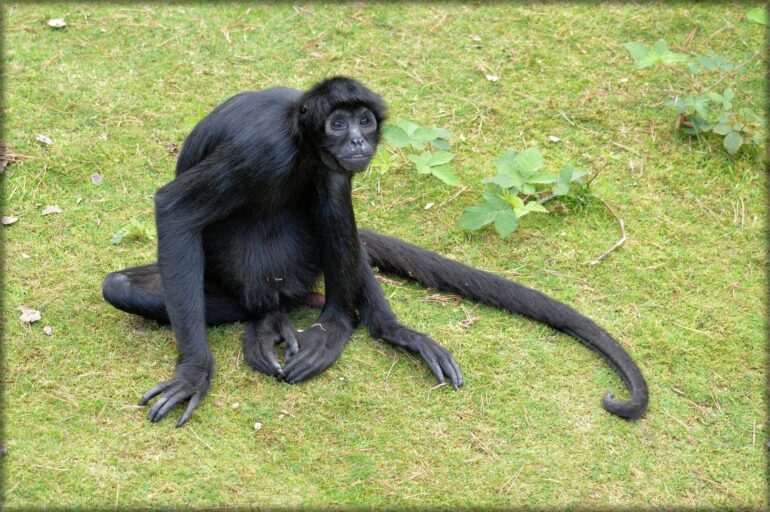TL;DR:
- Imperial College London study utilizes AI-enhanced acoustic monitoring to study spider monkey behavior.
- Geoffroy’s spider monkeys in Costa Rica avoid areas with less than 80% forest cover and stay away from main roads.
- ‘Passive acoustic monitoring’ (PAM) and AI model helped analyze 35,805 hours of audio data in just eight weeks.
- Monkey presence is linked to 80% forest cover, regardless of forest type, highlighting environmental sensitivity.
- Monkeys show tolerance to secondary roads but avoid primary paved roads within one kilometer.
- Insightful research guides conservation efforts and emphasizes the importance of balanced human impact.
Main AI News:
In a groundbreaking study conducted by researchers at Imperial College London, the intricacies of spider monkey behavior and habitat preferences have been unveiled through cutting-edge AI-enhanced acoustic monitoring. This innovative research, featured in the esteemed journal Proceedings of the Royal Society B, sheds light on the critical interplay between human activity and the conservation of these endangered species. Led by Dr. Jenna Lawson from the Department of Life Sciences and the Grantham Institute at Imperial, the study’s findings provide invaluable insights that could redefine conservation strategies.
Spider monkeys, specifically Geoffroy’s spider monkeys, found in the lush landscapes of Costa Rica, have been the subjects of this comprehensive study. The research elucidates that these primates display a remarkable sensitivity to their environment, with their presence heavily influenced by forest cover and proximity to human-made infrastructure. Astonishingly, the monkeys avoid areas with less than 80% forest cover and maintain a distance of at least one kilometer from paved main roads.
The research employs the novel technique of ‘passive acoustic monitoring’ (PAM), where strategically placed audio detectors capture the monkeys’ calls and interactions. This technique has proven to be a game-changer for studying elusive and wide-ranging species, as it enables researchers to gather data over extended periods and vast landscapes. However, the colossal amount of audio data collected necessitates advanced technology to sift through and identify relevant signals accurately. Enter AI: the research team harnessed the power of artificial intelligence to streamline data analysis, a move that accelerated the process and yielded remarkable results.
Amassing an impressive 35,805 hours of audio data from 341 sites, the team embarked on a data-driven journey to decode the monkeys’ habitat preferences and behavior patterns. This journey led to a pivotal discovery: the presence of spider monkeys is contingent upon a delicate equilibrium between environmental factors. The 80% forest cover threshold emerged as a decisive parameter for their habitat selection, indicating the monkeys’ unwavering connection to their forest home.
Notably, the study highlights the nuanced distinction between primary and secondary forests. While the monkeys exhibited resilience in both types of forest environments, as long as the forest cover remained at least 80%, the reason behind this phenomenon offers a fascinating insight. In Costa Rica, the secondary forests, regrown after clearance, are uniquely mature compared to those in other regions. This maturity allows the trees and their fruit to reach a stage of optimal development, aligning perfectly with the monkeys’ specialized diet.
Furthermore, the research underscores the profound impact of human infrastructure on these delicate ecosystems. While secondary gravel roads seemed to have minimal influence on the monkeys’ distribution, primary paved roads emerged as formidable barriers. The monkeys steered clear of areas within one kilometer of such roads, underscoring the profound ramifications of human disturbances on their natural habitats.
Dr. Cristina Banks-Leite, the lead researcher from the Department of Life Sciences, emphasizes the far-reaching implications of this study. She notes that the distinct effects of primarily paved roads only became evident through the comprehensive approach of their research. The study’s comprehensive coverage over time enabled the team to unravel the intricate relationship between spider monkeys and their environment. Dr. Banks-Leite highlights that while secondary roads pose relatively minor concerns, the monkeys’ presence is most pronounced in areas with limited human interventions, indicating their remarkable sensitivity to disturbances caused by human activities.
Conclusion:
The study’s innovative AI-driven acoustic monitoring approach offers crucial insights into spider monkey habitat preferences and responses to human activity. This research indicates that conservation efforts must consider the delicate interplay between forest cover and human infrastructure to ensure the survival of endangered species. Market stakeholders in environmental protection and conservation can leverage these findings to design more effective strategies that respect the intricate relationship between wildlife and their habitats, promoting sustainable practices and biodiversity preservation.

